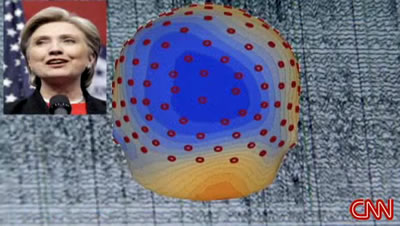Red Brain, Blue Brain

Just in time for analyzing Super Tuesday primary results, political neuromarketing is back in the news. CNN ran a story, Reading Voters’ Minds!, on how Lucid Systems is attempting to measure real voter attitudes with various techniques borrowed from neuroscience and medicine. (You can tell CNN was excited by the story because of the exclamation point in the title.) Unfortunately, the information presented in the CNN story looks like another case of overhyped neuromarketing data: a tiny sample size and subjective conclusions.
With a title that satirizes CNN’s breathless headline writing, Slate’s Daniel Engber points out some of the study’s limitations in Obama Builds Lead Inside Voters’ Brains! Neuropundits weigh in on Super Tuesday:
It turns out the researchers weren’t really looking at brains at all for three-quarters of the test group. Instead, they measured just two things: skin-conductance response – with the fingertip electrodes that have been used in conventional (and unreliable) lie detectors for at least 100 years – and movements in the corrugator supercilii muscle that furrows the brow when you’re displeased. Taken together, these signals give a rough sense of how intensely a voter dislikes a particular candidate. It’s a bit harder to tell if a voter secretly liked a candidate. (The other two subjects also had their brain activity measured via electroencephalography, which hinted at how strongly they associated each candidate with words like winner and leader.)
The EEG portion from the CNN clip puts things in terms that even a politician can understand: blue brain – negative, red brain – positive. Can it really be that simple?
According to Lucid’s website, the firm uses, “a combination of neurological and physiological disciplines designed to measure everything from pupil dilation and eye movement to galvanic skin response, brainwaves, and micro-muscle movement.” They add, “You can be confident in our conclusions because they’re validated from multiple perspectives.” These techniques offer some logistic advantages over fMRI, which requires a multi-million dollar machine and limits what the subject can do during the experiment. Unlike fMRI, though, they aren’t able to measure activity in specific locations in the brain.
I don’t doubt that valid neuromarketing data can be obtained by these convenient and non-invasive techniques. The “case studies” tab at Lucid’s website is empty now, but promises some for the first half of 2008. Unfortunately, journalists seeking a new angle on election coverage (and we’ve got another nine months left!) seem to seize on this kind of subjective study (see also Neuromarketing Shoots Itself in the Foot) and oversimplify what is a very complex process.
How can political marketing really benefit from neuroscience? One way would be to conduct neuromarketing studies before a vote and correlate the data with an exit poll in which the subjects indicate how they voted (assuming they tell the truth). With enough data, one might be able to identify specific brain or physiological activity that had a very high correlation with the candidate the subjects voted for, or didn’t vote for. One difficulty that neuromarketers share with conventional pollsters is that swing voter intentions can be very fluid, and in the days and hours before an election voters are barraged with information: campaign ads, push polls, personal contacts, last-minute revelations of real or invented misdeeds, and so on. Even if a seemingly definitive intention is identified a week before the vote, there’s no guarantee that the voter’s mind won’t be swayed in the ensuing days.
Another area that has more immediate application would be to gauge response to various issues – the war in Iraq, jobs, immigration, etc. – to see which produced the greatest voter reactions. This data could be useful in determining what campaigns should emphasize, even without extensive validation against later behavior.
November is a long way off, and I expect we’ll see more neurodata snippets spun into breaking news stories on how scientists can now “read voters’ minds.” As Dr. Atkins might have advised, look for the beef in these stories, and ignore the bun and condiments used to dress them up. As the Just Above Sunset blog notes about the CNN story, “It’s exciting, or nonsense.” Decide for yourself.
